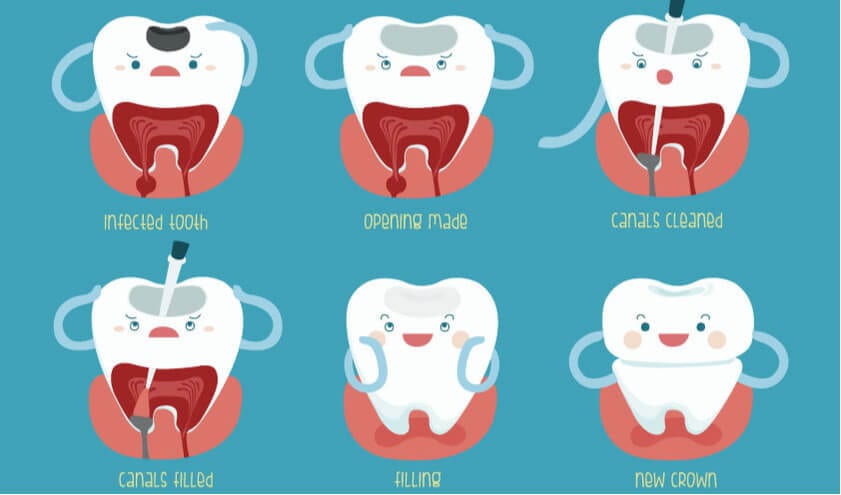What is Root Canal Treatment?
Understanding Root Canal Treatment Stages
Aside from being an undeserving synonym for pain and discomfort, root canals are somewhat of a mystery to most patients. Few, if any, know even the basic purpose of having a root canal and most patients don’t know and don’t consider what the various root canal treatment stages consist of. Endodontic therapy serves a very deliberate purpose and generally has very predictable treatment stages and outcomes. In order to better understand what a root canal is and why it is performed, it is helpful to examine the procedure step by step.
Diagnosis
As with most dental treatments, diagnosis is the obvious first step. The need for root canal treatment, though, is determined somewhat differently, since most patients who require endodontic therapy are experiencing pain to some degree. The pain is due to what is known as an “abscess” or “abscessed tooth.” The literal meaning of an abscess is a swollen area resulting from a bacterial infection. Many abscesses present as depressible bumps on the gum directly above the tooth, either on the inside or outside surface. However, not all infected teeth have swollen areas and, in some cases, may cause little to no pain.
However, most abscessed teeth have predictable symptoms. Dull, throbbing pain severe enough to interfere with sleeping is a telltale sign of an abscessed tooth. Sensitivity to cold and hot temperatures is also very common, and chewing on the tooth may be impossible to do without intense pain.
Diagnosing an abscessed tooth and prescribing root canal treatment consists of a series of tests determining a tooth’s ability to recover from its current state of infection. If a tooth is determined to be “non-vital,” a root canal is necessary to save it. If an infection is severe, the endodontist may choose to give the patient antibiotics prior to the procedure. In cases of severe swelling, a treatment known as “incision and drainage” may be performed to reduce swelling and discomfort.
Root Canal Treatment Stages
Once a tooth is anesthetized, the first step in root canal treatment is to create a hole in the top of the tooth, or the back of the tooth if it is a tooth in the front of the mouth. This hole allows access to the pulp chamber and the canals, which also contain pulp. The pulp is the primary source and nourishment for the infection and is removed from the tooth during a root canal. With the hole created, the pulp—which contains nerves and blood vessels—is removed from the tooth using specialized instruments.
With the pulp removed, the interiors of the canals are then prepared for filling. The canals are hollow spaces within the roots of teeth that contain the pulp. The empty canals must be thoroughly disinfected, shaped, and smoothed to make the filling process successful. In some cases, the endodontist may determine that two appointments are necessary to complete the root canal. In between appointments, a special disinfecting medicament may be placed in the canals, and a temporary filling will be placed in the hole that was made in the tooth.
Although each case is different, 2-4 weeks may need to pass before the root canal is completed. At the final appointment, the temporary filling is removed, and the canals are filled with a material known as gutta percha. Gutta percha is a naturally derived material that prevents future bacterial growth within the canals. Once the canals are filled, in most cases another temporary filling will be placed until such a time that the tooth receives its final restoration.
Restoring a Root Canal Treated Tooth
The last of the root canal treatment stages usually entails placement of a crown on the tooth. Crowns are utilized on root canal treated teeth in order to protect them and keep them strong for years to come. There are some cases in which a crown may not be used, such as if the root canal was performed on an anterior (front) tooth. These teeth may be restored by placing a tooth-colored filling material in the hole that was used for access to the pulp.
Teeth restored in this manner may be subject to discoloration over time. There are cosmetic treatments for this, most notably internal bleaching. Internal bleaching involves placement of a bleaching material within the tooth itself. This is possible only in root canal treated teeth, since they have an interior space to deliver bleaching material and cannot feel pain due to lack of a nerve. Internal bleaching is typically far more effective on root canal treated teeth than whitening materials applied to the exterior of a tooth.
Root canal treatment stages are, for the most part, relatively simple and straightforward. By simply understanding the purpose and method of each step, patients can not only understand the value of this tooth-saving treatment, they can feel more at ease without the fear of the unknown, so to speak.
Abscessed teeth are a true dental emergency and require prompt attention to ensure optimal treatment prognosis. If you are experiencing moderate to severe throbbing pain associated with a single tooth or area of the mouth, you should contact your endodontist right away. Left untreated, the infections associated with abscessed teeth can spread to other parts of the head and neck and present medical emergencies. No toothache, regardless of how minor, should be left to chance or self-diagnosis. By consulting your endodontist as soon as you suspect a problem, your entire root canal experience will go much more smoothly and will be far more successful.

